When we think of robotic eye surgery, we may mistakenly picture futuristic machines taking over while the human ophthalmologists are left out. Perhaps a better way of thinking about robotic ophthalmic surgery is to remember that it is robot-assisted. These new machines will assist surgeons, not replace them — and they can help us provide a higher level of precision and safety to our patients. Think of it this way: You are still the surgeon, but a better version of you, with faster reaction times, a higher degree of accuracy, more efficiency and a lower risk of surgical complications.
Already Among Us
We already use robotic devices in ophthalmic surgery, particularly in refractive surgery. With kerato-refractive laser procedures such as LASIK or lenticule extraction, the surgeon needs the assistance of these semi-automated lasers to produce the most accurate results for our patients. The ophthalmologist examines the patients to determine if they would be suitable candidates for laser vision correction, then uses human judgment to determine the degree of laser treatment to be performed as well as other parameters of the surgery.
In the case of LASIK, the patient is docked to our femtosecond laser, which then creates a very precise flap. The surgeon pivots the patient to the excimer laser, then carefully lifts the corneal flap before the excimer laser takes over. The excimer robot will then track the eye at hundreds of times per second and deliver the precise laser energy necessary to ablate the desired amount of cornea tissue. The surgeon then replaces the flap and smooths the surface. In this procedure, clearly robotic lasers did a large portion of the work, but the surgeon is still instrumental in the surgical success.
Coming to Cataract Surgery Soon
Robot-assisted cataract surgery is currently in development, with major advances already made amid a rapid evolution of the technology. For example, robots can increase accuracy of movement to 1 micron compared to 40 microns for a human alone. The robot can also eliminate any surgeon hand tremors. The robotic cataract surgery devices can be used in three modes: remote surgery, assisted surgery and automated surgery.
Remote surgery, also called telesurgery, means that the surgeon is in one location while the robot and the patient are in another. These two locations can be 10 meters apart or 10,000 kilometers apart while the surgeon uses the controls to perform the surgery.
Assisted surgery allows the robot to improve upon human abilities, such as increasing the level of precision, eliminating a tremor or providing increased tactile feedback for tissue manipulation. The robot can also assist with reaction times — it can be more than 10 times as fast as a human. A talented surgeon has a reaction time of 200 milliseconds. A professional F1 racecar driver has a reaction time as fast as 100 milliseconds. The robot can be 10 times faster than that, reacting in just 10 milliseconds or less (data on file at Horizon Surgical Systems).
Similarly, robots can acquire visual data during surgery at a much higher rate than humans. When we watch a movie or television show, we take in the world at about 30 to 60 frames per second. In contrast, the robot uses two high-definition, high-speed cameras to acquire three-dimensional video at 100 to 1,000 frames per second, according to Horizon Surgical Systems. The robot also has swept-source optical coherence tomography (OCT) imaging that allows it to see at a resolution beyond what we can perceive, including continually monitoring the position of the posterior capsule. Rupture of the posterior capsule is a potential complication of cataract surgery because this 4-micron-thin tissue, which is clear, tends to be mobile with the fluid currents of surgery. The robot can visualize it and keep track of it far better than any human surgeon can.
The final frontier is automated surgery, but that is still under the watchful eye of the surgeon. We are using forms of this now with femtosecond laser-assisted cataract surgery. Once the surgeon confirms the treatment plan and docks the eye to the laser, the energy delivery to create corneal incisions, perform a capsulotomy, and divide the nucleus into fragments is automated. The surgeon can interrupt the robotic laser at any point and take over if needed. All data is also analyzed with artificial intelligence models so that the robot continually learns and improves over time.
Improved Precision, Safety and Efficiency
Using a new robotic system to perform cataract surgery can result in a higher margin of safety, a faster reaction time, and earlier detection of issues. The precision is far more than what we can achieve with our hands alone. The robots can also help us improve throughput and allow a surgeon to perform more cases per hour. This is increasingly important, as the number of cataract surgeries needed is growing faster than our ability to perform them. One surgeon can supervise multiple robots at once and then pause one or more of them if needed so that the human can take over.
Think of the cataract surgery robot as something similar to the autopilot feature used on commercial airliners. These devices make flying safer; they prevent many types of human error and they never get tired. Most importantly, these robotic devices, whether in cataract surgery or in airplanes, make the work less stressful for us humans. It would be great to have a full day of many dozens of cataract surgeries with a lower level of stress for me as the surgeon. OM










